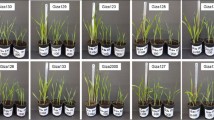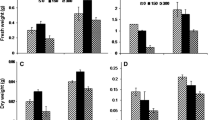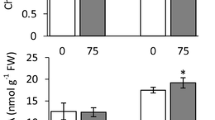Abstract
Four breviaristatum (short awned and semi-dwarf) barley mutants; ari-e.1, ari-e.119, ari-e.156 and ari-e.228 were compared with other semi-dwarf mutants; Golden Promise, Alf, Pallas and Diamant along with their non-mutant parents; Bonus, Foma, Maythorpe, Bomi and Valticky, for response to salt stress. Plants were exposed to hydroponic salt treatments (NaCl at 25 and 175 mol m-3) for 4 weeks, after which response was measured in terms of shoot dry weight, sodium content and δ13C. In general ari-e mutants and Golden Promise had significantly lower Na+ contents than the other mutants. They also had significantly more negative δ13C values than the other lines in stressed (175 mol m-3 NaCl) conditions. There was a positive correlation (r = 0.71, p < 0.01) between shoot Na+ and δ13C values so that δ13C became less negative with increasing Na+ content. Shoot dry weights were compared to shoot Na+ and δ13C values. The ari-e and Golden Promise mutants showed less reduction in dry matter production in salt stress relative to the control treatment than all the other lines. The data suggest that ari-e mutants and Golden Promise are better adapted to salt stressed environments than the other lines examined. Tests for gibberellic acid sensitivity revealed that ari-e mutants and Golden Promise responded weakly to GA3, while other dwarf mutants Pallas, Diamant and Alf along with their parents Bonus, Foma, Maythorpe, Valticky and Bomi were highly sensitive. Our results support previous findings that ari-e mutants and the GPert mutant are allelic.
Similar content being viewed by others

References
Barua, U.M., K.J. Chalmers, W.T.B. Thomas, C.A. Hackett, V. Lea, P. Jack, B.P. Forster, R. Waugh & W. Powell, 1993. Molecular mapping of genes determining height, time to heading and growth habit in barley (Hordeum vulgare). Genome 36: 1080–1087.
Borg, G., 1959. Svalöf's original Pallas barley (Sv. 04032), a new 2-row spring barley produced by X-ray treatment of Svalöf's Bonus barley. Sveriges Utsadesfor. Tidskr: 72–96.
Bouma, J., 1967. New variety of spring barley, ‘Diamant’ in Czechoslovakia. In: Induzierte Mutationen und ihre Nutzung, Erwin Baur Gedächtnisvorlesungen IV, 1966, Abh Dt Akad Wiss Berl Akademie-Verlag, Berlin.
Ehdaie, B., A.E. Hall, G.D. Farquhar, H.T. Nguyen & J.G. Waines, 1991. Water-use efficiency and carbon isotope discrimination in wheat. Crop Science 31: 1282–1288.
Farquhar, G.D. & R.A. Richards, 1984. Isotopic composition of plant carbon correlates with water-use efficiency of wheat genotypes. Aust J Plant Physiol 11: 539–555.
Forster, B.P., 1992. Genetic engineering for salt tolerance in Triticeae. In: W. Powell, J.R. Hillman & J.A. Raven (Eds) Opportunities and Problems in Plant Biotechnology. Proceedings of The Royal Society of Edinburgh, 99B(3/4): 89–106.
Forster, B.P., H. Pakniyat, M. Macaulay, W. Matheson, M.S. Phillips, W.T.B. Thomas & W. Powell, 1994. Variation in the leaf sodium content of Hordeum vulgare (barley) cultivar Maythorpe and its derived mutant cv. Golden Promise. Heredity 73: 249–253.
Franckowiak, J.D., 1991. Allelism tests among selected semidwarf barleys. Barley Genetics Newsletter 21: 17–23.
Greenway, H. & R. Munn, 1980. Mechanisms of salt tolerance in non-halophytes. Ann Rev Pl Physiol 31: 149–190.
Gale, M.D. & C.N. Law, 1977. The identification and exploitation of Norin 10 dwarfing gene. Rep Plant Breed Inst Cambridge 1976: 21–35.
Gorham, J., E. Budrewicz, R.G. Wyn Jones, 1985. Salt tolerance in the Triticeae: growth and solute accumulation in leaves of Thinopyrum bessarabicum. J Exp Bot 36: 1021–1031.
Haahr, V. & D. von Wettstein, 1976. Studies of an induced high yielding dwarf-mutant of spring barley. In: H. Gaul (Ed.) Barley Genetics III. Verlag Karl Thiemig, Munich: 215–218.
Hanson, P.R., J.A. McVittie & J.L. Smalley, 1980. Seedling response to exogenous gibberellic acid in spring barley. Z Pflanzenzüchtg 84: 115–121.
Handley, L.L., M.J. Daft, J. Wilson, C.M. Scrimgeour, K. Ingleby & M.A. Sattar, 1993. Effects of the Ecto-and VA-mycorrhizas (Hydnangium carneum and Glomus clarum) on the δ15N and δ13C values of Eucalyptus globulus and Ricinus cummunis. Plant, Cell Env 16: 375–382.
Kucera, J., U. Lundqvist & A. Gustafsson, 1975. Induction of breviaristatum mutants in barley. Hereditas 80: 263–278.
Laurie, D.A., N. Pratchett, C. Romero, E. Simpson & J.W. Snape, 1993. Assignment of the denso dwarfing gene to the long arm of chromosome 3 (3H) of barley by use of RFLP markers. Plant Breeding 111: 198–203.
Pakniyat, H., M. Macaulay & B.P. Forster, 1994. A salt tolerant mutation in Barley. In: Scottish Crop Research Institute Annual Report 1993: 40–42.
Persson, G., 1969. An attempt to find suitable genetic markers for dense ear loci in barley. Hereditas 62: 25–96.
Persson, G. & Hagberg, A., 1969. Induced variation in quantitive characters in barley. Morphology and cytogenetics of erectoides mutants. Hereditas 61: 115–178.
Sigurbjornsson, B. & A. Micke, 1969. Progress in mutation breeding. In: Induced Mutation in Plants. Proc Symp Nature, Induction and Utilization of Mutation in Plants, Intern Atomic Energy Agency, Vienna: 673–697.
Steel, R.G. & J.H. Torrie, 1980. Principles and Procedures of Statistics, a Biometrical Approach. 2nd edition. McGraw-Hill Book Co., New York.
Taeb, M., R.M.D. Koebner, B.P. Forster & C.N. Law, 1992. Association between genes controlling flowering time and shoot sodium accumulation in the Triticeae. Plant and Soil 146: 117–121.
Thomas, W.T.B., W. Powell & W. Wood, 1984. The chromosomal location of the dwarfing gene present in the spring barley variety Golden Promise. Heredity 53: 177–183.
Author information
Authors and Affiliations
Rights and permissions
About this article
Cite this article
Pakniyat, H., Handley, L., Thomas, W. et al. Comparison of shoot dry weight, Na+ content and δ13C values of ari-e and other semi-dwarf barley mutants under salt-stress. Euphytica 94, 7–14 (1997). https://doi.org/10.1023/A:1002956802041
Issue Date:
DOI: https://doi.org/10.1023/A:1002956802041



